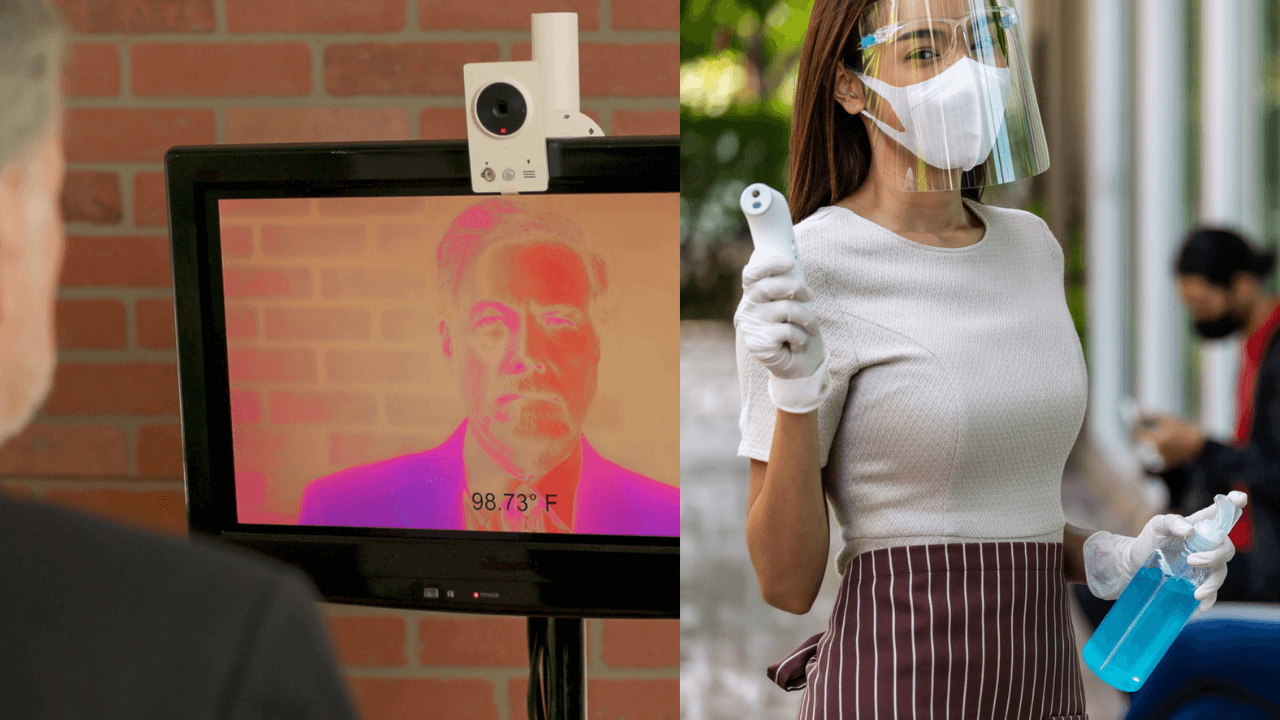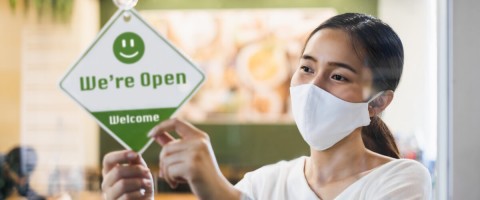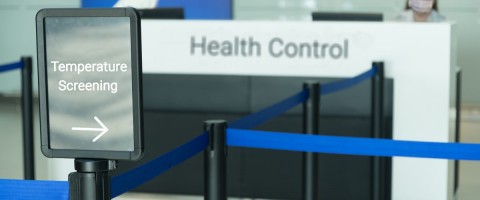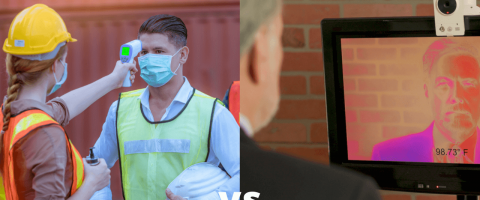Prefer to listen to this article?
Your new normal requires new answers.
When it comes to commercial temperature screening to prevent Coronavirus transmission among your team and customers, you’re certainly not the only one with questions. To provide answers and help you sift through misinformation, we decided to answer some of the most frequently asked temperature screening questions.
Why is fever the leading indication of COVID-19 infection over other symptoms?
Screening for fever plays a unique role in limiting COVID-19 transmission due to its prevalence and detectability. While it’s true that some people infected with COVID-19 may never exhibit a fever and that others may never show any symptoms at all, fever is the most common as well as the most easily detectable sign of infection.
Are all increased temperatures (+ 98.6°F) considered a fever?
No. Not all elevated body temperatures constitute a fever. The human body can fluctuate anywhere between 97°F (36.1°C) to 99°F (37.2°C) without surpassing the threshold of what is considered a fever. A temperature exceeding 100.4° F is officially considered a fever, but many choose to use 100° F as the maximum tolerated temperature.
Is the temperature screening of employees considered a HIPAA violation?
No—temperature screening does not violate HIPAA protections. Yes, temperature screening is technically considered a form of medical examination whose results should be kept confidential and separate from other personnel information to comply with ADA obligations. However, in most cases, an employer’s HIPAA obligations are only limited to covered health plans.
Can an employer legally require employees to submit to temperature screening?
Yes—employers are permitted to require temperature screenings for their employees. There has been some confusion about this because this wasn’t always the case. However, as of March 21, 2020, the Equal Employment Opportunity Commission (EEOC) published new guidelines stating that the verification of normal employee temperatures is acceptable during the COVID-19 pandemic. While this is the case, employee temperature data or any other medical information should be kept confidential per ADA regulations—including the fact that they were found to have a fever or why they were sent home. All information regarding an employee’s health should remain on a strict need-to-know basis. Secondary recommendations:
- While mandatory temperature screenings are permitted, it’s recommended that employees are provided written notice that outlines how such screenings will be taking place, what will happen for those with a detectable fever, and the consequences for those who fail to comply with screening protocols.
- The EEOC advises employers to screen all employees and workplace occupants to prevent perceived or actual discrimination.
What temperature screening methods currently exist?
The two most common temperature screening methods are —
(a) manual, human-conducted temperature screenings by selected staff members at workplace or business entrances, or
(b) automated, device-conducted screenings by strategically placed technologies.
What type or style of thermometer should be used for temperature screening?
To decrease the likelihood of viral transmission for screeners, employees, and customers, it is recommended to use a contact-free infrared thermometer approved for humans. Depending on the screening and device method, a reliable temperature reading can be obtained from the forehead or wrist of the screened individual.
Are infrared thermometers safe?
Yes—infrared thermometers are completely safe. Despite the name, infrared thermometers do not emit infrared radiation, but rather detect infrared radiation levels emanating from surfaces. The laser-like light displayed from the infrared thermometer is a harmless aiming guide for thermometer users.
Are contact-free infrared thermometers as accurate as traditional mercury thermometers?
Yes—research has confirmed that infrared thermometers are as accurate as traditional thermometers for temperature screening.
Can atmospheric conditions produce erroneous readings for infrared thermometers?
Yes and no—the misuse of infrared thermometers can result in inaccurate readings. Direct sunlight on the skin outdoors or wind gusts can produce interference. When used in shaded areas free of obstructions to the skin (such as hair, hats, glasses, etc.) or free of excessive airflow, accurate readings can be easily obtained by infrared thermometers.
Can hot flashes in women result in false fever-level ratings?
No—hot flashes do not raise women’s body temperatures to the threshold that would be considered a fever. Most hot flashes only produce a flushed sensation while not actually resulting in elevated body temperature.
How can I best protect employees who are conducting manual temperature screening?
There are several ways to preserve the health of manual temperature screeners.
- Before conducting a screening, screeners should ask the person being screened if they’ve recently displayed symptoms of COVID-19—including fever, shortness of breath, body aches, fatigue, or loss of taste or smell. The presence of these symptoms may disqualify a further need to screen someone’s temperature—preventing a possibly infected person from coming any closer.
- When not actively conducting a temperature screening, screeners should remain at least six feet from others.
- Everyone involved should be required to wear protective masks to prevent transmission.
- Screeners should don protective gloves and eye protection to limit exposure to thermometers placed close to possibly infected individuals.
- When possible, screeners should stand behind a physical barrier, such as a plastic window or screen that can deflect infected individuals’ respiratory drops. The thermometer, however, should be read the unobstructed skin of the individual.
- Screeners should adequately dispose of all personal protective equipment (PPE) in prescribed receptacles before leaving the screening areas.
- Screeners should thoroughly wash their hands with soap and water for at least 20 seconds or use hand sanitizers with at least 60% alcohol any time they leave the screening area.
- Thoroughly training screeners is essential, including the recommendation that they assume every individual being screened is a possible virus carrier.
- Lastly, to protect all employees, incorporating an automated temperature screening device may be advised.
What if an employee or customer refuses to have their temperature screened?
For would-be customers who refuse to have their temperature screened, private businesses are well within their rights to refuse service to them on a non-discriminatory basis. A temperature check to enter a restaurant is no different from walking through a metal detector to enter a large concert hall or a sports arena—the facility has the right to institute any nondiscriminatory protocols to protect other customers and staff. Rules like “no shirt, no shoes, no service” can legally be extended to “no mask, no temperature screening, no entry.”
Though barring an employee who may or may not display symptoms of COVID-19 (i.e., a fever) seems a tad trickier, as of March 21, 2020, the above mentioned EEOC regulations permit employers to deny entry to employees who don’t comply with temperature screening protocols or refuse to answer questions about their own health regarding COVID-19.
What should I do if a customer or employee presents a fever upon scanning?
If a customer or employee presents a temperature over 100° F, the screener should discreetly inform them that their current bodily temperature is above the threshold required for entry. Discretion is key—not only out of respect for the privacy of the individual but also as a means of remaining compliant with ADA protocols, which require all employee health information remains confidential. For this reason, it’s recommended that screening areas are kept away from common areas to protect the safety and privacy of employees.
For those exhibiting or admitting they have recently experienced symptoms associated with COVID-19, a discreet exit should be made available along with instructions regarding the following steps. News of an employee exhibiting any such symptoms should only be shared with the necessary company authorities. These authorities should safely reach out to the individual with the company’s time-off policies and requirements necessary for them to return to work.
Should I compensate employees for the time it takes them to undergo temperature screening?
Yes—you should always add the time necessary to receive temperature screening for all non-salaried employees. Not paying employees for the time it takes for them to do what is needed to work is likely a violation of the Fair Labor Standards Act.
Which employees or customers should I temperature screen?
If you’re going to temperature screen any customers or employees, you should screen everyone. Selectively scanning individuals, even in an allegedly random fashion, can still be seen as discriminatory. Selective temperature screenings may result in a violation of EEOC regulations and federal anti-discrimination laws.
From the CEO to the most recent hire, screening everyone is an excellent means of fostering your team’s solidarity during these uncertain times. If any senior-level team members are allowed to forgo temperature screenings, this will likely breed resentment among departments or staff members and result in dashed company morale.
Automated Temperature Screening Made Simple
If you have decided to adopt temperature screening as a practice for your workplace, business, or school system, congratulations! You’re taking a bold step towards protecting your customer, employees, or students’ health and well-being. Engaging in this endeavor, however, can have many separate parts that must work in tandem. From deciding to either pursue a manual approach with employees or using devices that must be properly installed and maintained, the process requires more than merely flipping a switch.
Fortunately for businesses, workplaces, and schools in the Greater Tulsa, Oklahoma area, JD Young Technologies is here to help make temperature screening safe and simple. JD Young’s technology specialists are ready to answer any question you have about temperature screening systems and outfit your organization with the devices necessary to help keep your customers, employees, or students safe.







